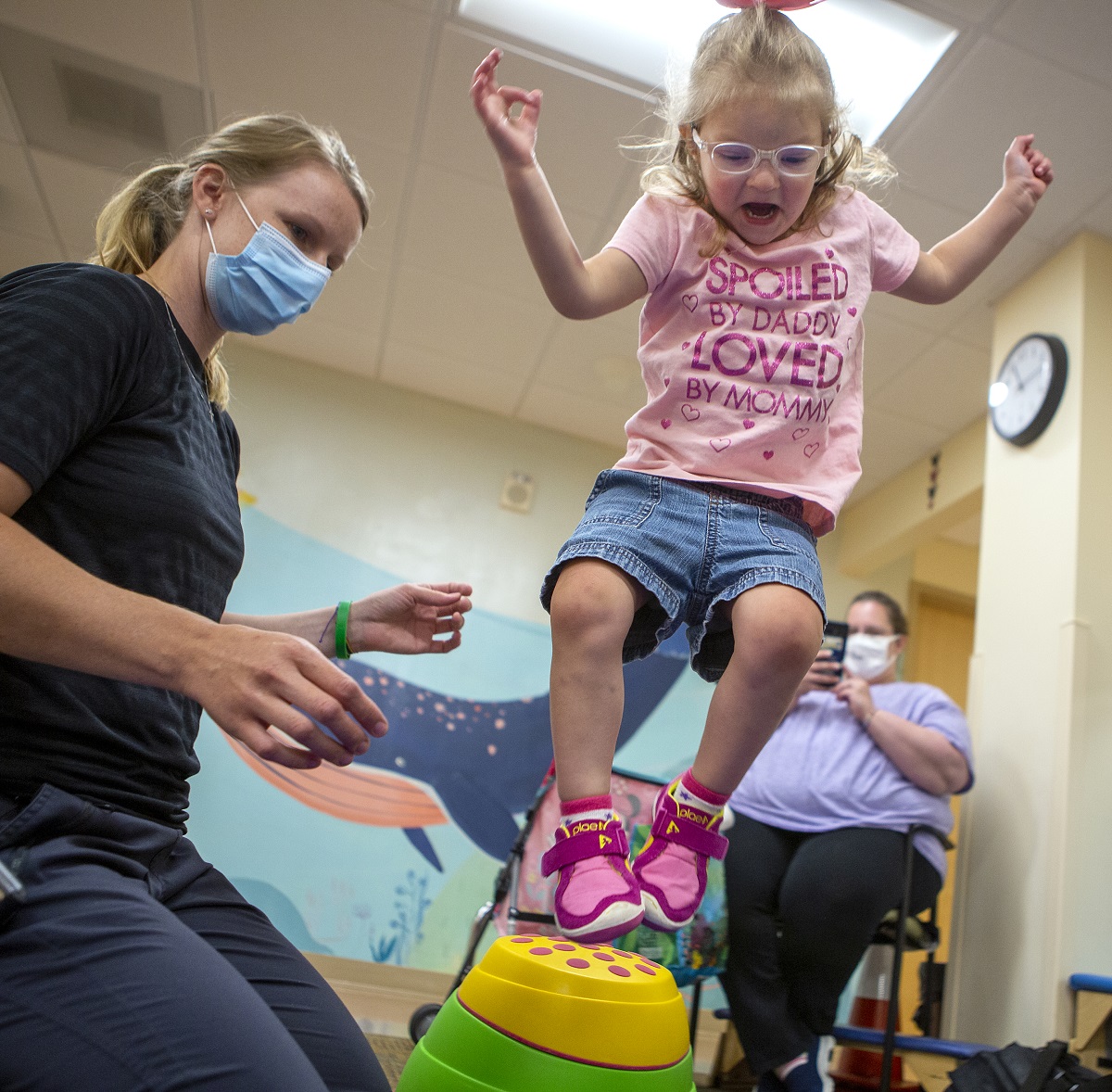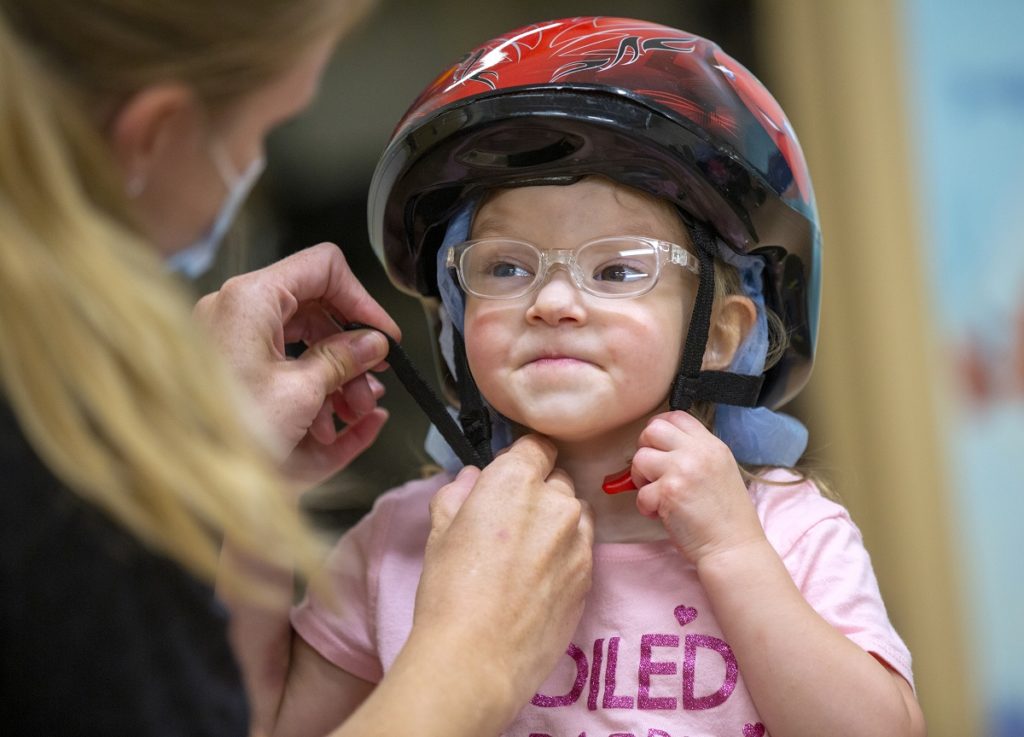Kids can’t wait: Families battle challenges of therapy during COVID

It was like Christmas in July for the Migliori family when 4-year-old Joella returned to physical therapy at the Penn State Therapy Services Building after a four-month, precautionary absence.
The Lewisberry girl was all smiles as she made a beeline for the stepping stones, a tool that helps strengthen her weak, uneven hip muscles. She punctuated her delight with fist pumps, just like she does on Christmas morning.
Joella was born with VACTERL association, which stands for vertebral defects, anal atresia, cardiac defects, tracheo-esophageal fistula, renal anomalies and limb abnormalities. She went through 15 surgeries before she was 6 months old, including open heart surgery at 16 weeks. Many times, her parents, Janette and Mario Migliori, thought they might lose her.
At the start of 2020, after years of living in what Janette Migliori characterized as “survival mode,” they had finally hit their stride. Joella had learned to eat all her calories by mouth rather than a feeding tube, and physical therapy was strengthening her hip muscles so she was falling less.
Then COVID-19 hit.
In the early weeks of the novel virus, Janette Migliori, like many parents of children who need regular therapy, agonized over whether to take her.

Joella Migliori gets help with her inhaler from her mother, Janette Migliori.
“I wanted to cry,” Migliori said. “I was afraid. This is a kid who has chronic lung disease and takes inhalers twice a day. It was either take the chance of her getting sick with COVID or keep her home and try to do therapy with her myself.”
Migliori chose the latter but soon found she didn’t have the right tools or expertise.
“I was starting to see all her hard work at therapy unravel,” Joella’s mother said. “She was falling again, and the bruises were back.”
The COVID-19 shutdown dealt a heavy blow to many children who need therapy that can’t stop for a pandemic. While in-person services were never shuttered, each family had to weigh the risks vs. the benefits.
“Parents were definitely stressed by trying to make that decision and, initially, a very large percentage chose not to come in,” said Jena Shovlin, pediatric occupational therapist. “Therapy is important to support the development of children with deficits in physical, cognitive, sensory, speech/language and perceptual deficits. It also helps the child and their family to learn how to adapt to their challenges to maximize their participation in daily life.”
While telehealth therapy visits can be beneficial for some patients, others may need in person therapy sessions to make progress. “It’s also hard to pick up on the little nuances you can catch in person that let you know they are tired or frustrated,” Shovlin said.
Joella’s parents purchased a few therapy aids for use during her virtual therapy sessions, but it was a huge relief to go back to in-person visits.

With help from physical therapist Emily Hoffman, Joella Migliori dons her bike helmet in preparation for a ride down the hallway.
“I still worry about her getting COVID – she is 4; she doesn’t keep a mask on that well – but we’re already seeing benefits,” Migliori said. For 15-year-old Caden Capitani, who has Down syndrome and verbal apraxia – or difficulty making his speech muscles work to result in accurate sounds and words – virtual speech therapy was a challenge.
“We were starting to see regression,” said Caden’s mother, Jessica Capitani. “It took him a year to add one syllable to a word – to say ‘banana’ instead of ‘bana’ – and now I’m hearing ‘bana’ again.”
She also noticed her very social son was remaining silent when people talked to him, and she knew it was because he feared he couldn’t intelligibly say what he wanted to say.
“Our insurance paid for a limited amount of virtual speech therapy sessions and then it ran out, so we had a choice to wait it out or mask up and go in,” Jessica Capitani said. “We masked up.”
When Caden returned to 30 Hope Drive last month, he was running down the hall because he was so excited to see his therapist, Megan Klinger.
People at clinical work stations can view video here. Click the cc button to turn on closed captioning.
“After his first session back, I could see a difference,” Caden’s mom said. “He wanted to impress Megan, and he nailed it. He seemed to have renewed focus, so maybe the break was actually good.”
Both mothers say safety protocols make them feel it’s safe to be back, and they already knew cleanliness was a top priority even before COVID.
While many children with complex medical issues haven’t returned to in-person sessions, Shovlin said it’s gratifying to see only minor regression among the children who are back.
The therapists are working with each family’s schedule to find ways to best meet their treatment plan, whether that be in person or telehealth visits, Shovlin said.
“We’ve missed the kids a lot,” she said. “We missed their smiles and their laughter.”
Joella and Caden will be featured during the Children’s Miracle Network Telethon benefitting Penn State Health Children’s Hospital, Aug. 31 through Sept. 3 on WGAL8. Donations benefit research, equipment and programs such as therapy services. In recent months, CMN Hershey has donated a tilt-in-space wheelchair for medically complex patients and Strider bikes sponsored by Quality Bicycle Products. Learn more at CMNHershey.org.
Click the image below for a gallery of photos.
If you're having trouble accessing this content, or would like it in another format, please email Penn State Health Marketing & Communications.

